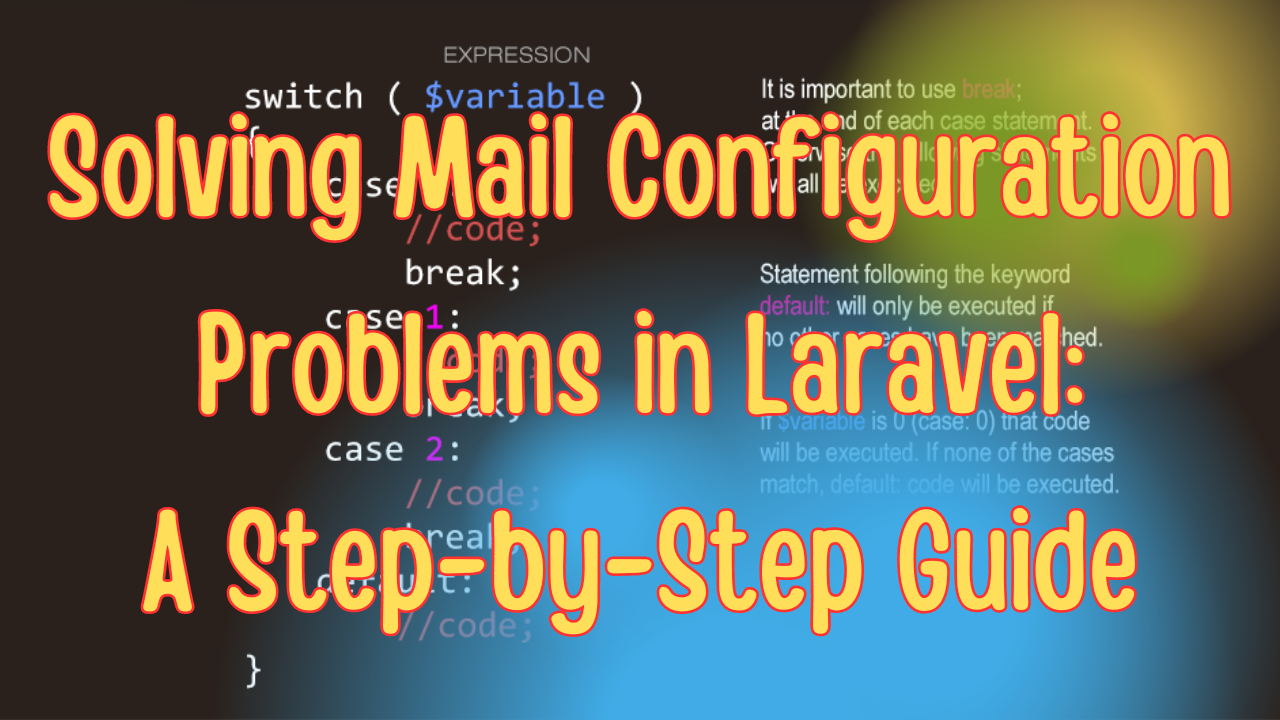Email functionality is an essential part of many Laravel applications, whether it’s for user notifications, password resets, or order confirmations. However, configuring mail in Laravel can sometimes be tricky. Issues like emails not being sent, configuration errors, or messages being marked as spam can cause significant headaches. In this blog post, we’ll walk you through common mail configuration problems in Laravel and how to solve them with practical steps and code examples.
1. Understanding Laravel’s Mail Configuration
Before diving into solutions, it’s crucial to understand how mail configuration works in Laravel. The primary configuration file for mail is located at:
config/mail.php
Here, you can set the default mail driver and other important parameters like SMTP settings, encryption, and port. Laravel supports several mail drivers including smtp, mailgun, postmark, ses, and sendmail.
Typical Mail Configuration in .env:
MAIL_MAILER=smtp
MAIL_HOST=smtp.mailtrap.io
MAIL_PORT=2525
MAIL_USERNAME=your-username
MAIL_PASSWORD=your-password
MAIL_ENCRYPTION=tls
MAIL_FROM_ADDRESS=example@example.com
MAIL_FROM_NAME="${APP_NAME}"
Now, let’s explore common mail issues and how to fix them.
2. Common Laravel Mail Configuration Issues and Solutions
Issue 1: Emails Are Not Being Sent
Problem:
Your Laravel application is configured correctly, but emails are not being sent or received.
Solution:
-
Check Environment Configuration: Verify that your
.envfile has the correct settings:- Double-check the
MAIL_HOST,MAIL_PORT,MAIL_USERNAME,MAIL_PASSWORD, andMAIL_ENCRYPTIONvalues. - If using services like Gmail, ensure
MAIL_ENCRYPTIONis set totlsandMAIL_PORTis587.
Example
.envconfiguration for Gmail:MAIL_MAILER=smtp MAIL_HOST=smtp.gmail.com MAIL_PORT=587 MAIL_USERNAME=your-email@gmail.com MAIL_PASSWORD=your-app-password MAIL_ENCRYPTION=tlsFor Gmail, remember to generate an app password if you’re using 2-step verification.
- Double-check the
-
Test Mail Configuration: Use a quick test to confirm if your configuration is correct. You can create a route to send a test email:
Route::get('/send-test-email', function () { Mail::raw('This is a test email from Laravel', function ($message) { $message->to('recipient@example.com') ->subject('Test Email'); }); return 'Email sent!'; });Visit
http://your-app-url/send-test-emailto see if the email is sent. -
Check Mail Logs: If emails are still not sending, check the logs in
storage/logs/laravel.logfor any error messages.
Issue 2: SMTP Authentication Errors
Problem:
You’re receiving authentication errors when trying to send emails via SMTP.
Solution:
-
Double-check Credentials: Ensure that your
MAIL_USERNAMEandMAIL_PASSWORDare correct. -
Check the SMTP Port: For example, Mailtrap typically uses
2525, while Gmail uses587. -
Ensure Correct Encryption: For Gmail, use
tls; for other providers like Mailgun or Postmark, check their documentation. -
Enable Less Secure Apps (if applicable): For Gmail, you might need to enable "Less secure app access" or generate an app-specific password if 2FA is enabled.
Issue 3: Emails Marked as Spam or Not Delivered
Problem:
Emails are being sent, but they are landing in the spam folder or not being delivered at all.
Solution:
-
Use a Professional SMTP Service: Free services like Gmail are more prone to spam filtering. Consider using a professional email service like Mailgun, SendGrid, or Amazon SES.
-
Set Up SPF, DKIM, and DMARC Records: Adding these DNS records will improve email deliverability. You’ll find the required records in your email service provider’s documentation.
-
Avoid Common Spam Triggers: Words like “Free,” “Click Here,” or “Buy Now” can trigger spam filters. Ensure your email content is clear and professional.
Issue 4: Connection Timeout Errors
Problem:
You’re experiencing timeout errors when sending emails.
Solution:
-
Increase Timeout in Configuration: You can increase the timeout setting for the SMTP driver in
config/mail.php:'timeout' => 60, -
Verify Network Connectivity: Ensure your server can reach the SMTP server. Test connectivity with:
telnet smtp.mailtrap.io 2525 -
Check Firewall Settings: Make sure your server’s firewall isn’t blocking outgoing connections on the SMTP port.
Issue 5: Mail Not Using Correct "From" Address
Problem:
Emails are being sent, but they’re not using the correct “From” name or address.
Solution:
-
Set the Default "From" Address in
.env:MAIL_FROM_ADDRESS=no-reply@yourdomain.com MAIL_FROM_NAME="Your App Name" -
Override in Code: You can also override the "From" address within your mail class:
public function build() { return $this->from('custom-from@example.com', 'Custom Name') ->subject('Custom Subject') ->view('emails.example'); }
Issue 6: Mail Configuration Not Updating After Changing .env
Problem:
You’ve updated your .env file, but the mail settings are not reflecting.
Solution:
-
Clear Config Cache: Laravel caches configuration values, so you need to clear the cache after making changes:
php artisan config:cache -
Restart Queue Workers: If you’re using queue workers, don’t forget to restart them:
php artisan queue:restart
Issue 7: Debugging Mail Issues in Local Development
Problem:
You want to safely test mail functionality in your local environment without sending real emails.
Solution:
-
Use Mailtrap for Local Development: Mailtrap is a great tool for testing emails in a safe sandbox environment.
Example configuration:
MAIL_MAILER=smtp MAIL_HOST=smtp.mailtrap.io MAIL_PORT=2525 MAIL_USERNAME=your-username MAIL_PASSWORD=your-password MAIL_ENCRYPTION=null MAIL_FROM_ADDRESS=no-reply@yourapp.com -
Use Log Driver for Testing: You can use the
logmail driver to log email details instead of sending them:MAIL_MAILER=logEmails will be logged to
storage/logs/laravel.log.
3. Advanced Tips for Laravel Mail Configuration
-
Using Different Mail Drivers: Laravel allows you to use different mail drivers for specific emails. For example:
Mail::mailer('mailgun')->to($user)->send(new WelcomeEmail($user)); -
Handling Mail Failures Gracefully: Implement error handling in your mail jobs to avoid unexpected crashes:
try { Mail::to($user)->send(new WelcomeEmail($user)); } catch (\Exception $e) { Log::error('Mail send failed: ' . $e->getMessage()); } -
Tracking Email Delivery: Services like Mailgun and SendGrid offer tracking and analytics for email delivery. Use these tools to monitor open rates, bounces, and other metrics.
Conclusion
Email configuration issues in Laravel can be frustrating, but with the right approach, they can be resolved quickly. By ensuring your SMTP settings are correct, using professional email services, and properly configuring your DNS records, you can avoid most common problems. Always test your configuration locally and monitor your production environment to ensure seamless email delivery.
With these solutions and best practices, you can confidently handle any Laravel mail configuration challenge!




